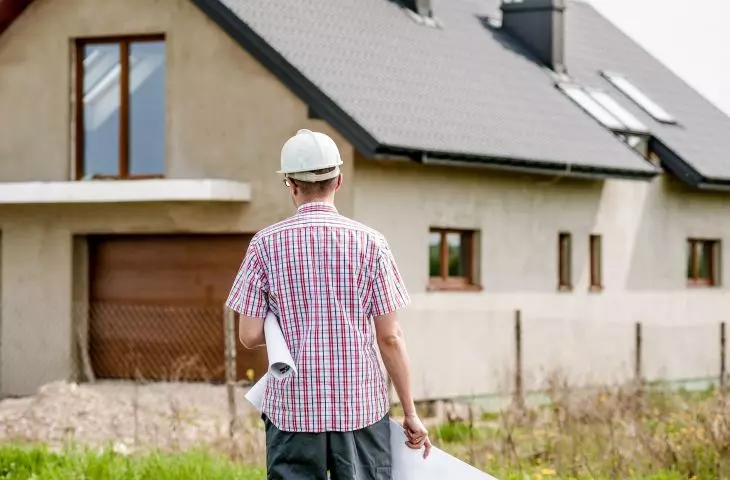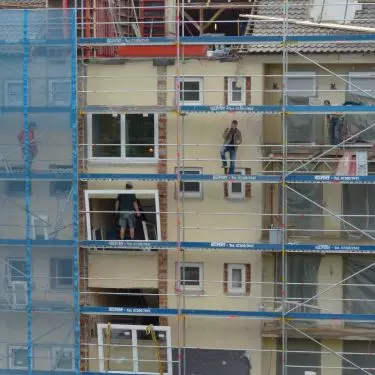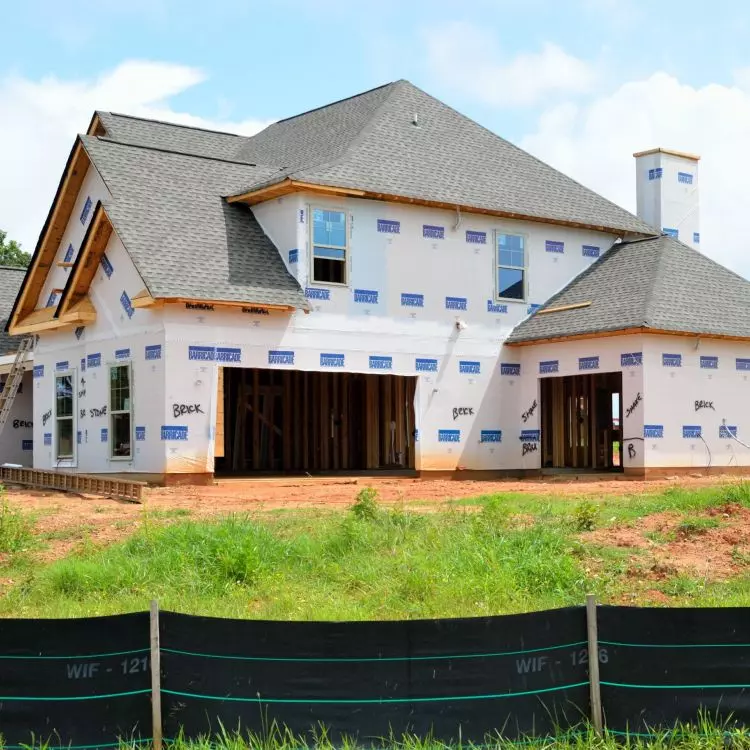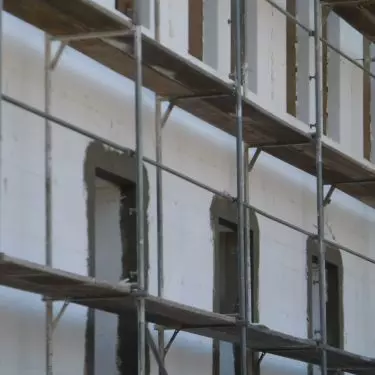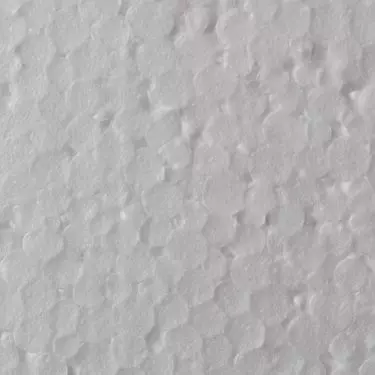In our climate zone, insulating buildings is a hot topic! Winters have become a bit milder, but the autumn transition period and cool pre-winter extend the heating period. If you want to keep the heat in the building, you need to plan effective thermal insulation. Is styrofoam a good insulation material? In many cases - yes. However, in order to get the most out of styrofoam, it is worth learning about its many types and how to optimally match them to your needs.
Why does styrofoam insulate against heat?
Styrofoam is a synthetic building material, available in the form of lightweight and rigid foam boards. Its correct name is expanded polystyrene, so you may often encounter the abbreviation EPS. The process of its production involves foaming the polystyrene granules, that is, enclosing air in its pores. It is assumed that air is as much as 98% of the volume of polystyrene foam! In the structure obtained lies the secret of its properties: it is the air bubbles that are a barrier to temperature.
Air is as much as 98% of the volume of polystyrene foam! It is the air bubbles that form a barrier to temperature and determine its insulating properties.
Photo: Humusak © Pixabay
Numerous types of polystyrene boards have several common properties that favor their widespread use in construction:
-
they are light - a packet of 0.3 m³ of facade polystyrene weighs only about 3-4 kg,
-
they do not soak up water,
-
when ignited, they extinguish themselves,
-
are ecological and safe for health,
-
are durable and maintain constant dimensions.
However, let's say it openly - styrofoam has some disadvantages. You need to know that it is a rather fragile material, so it requires additional protection from damage. In addition, not every styrofoam will perform the function of sound insulation. Be sure to take a look at the article, in which we advise how to approach this issue!
From what polystyrene foam to make thermal insulation?
Thanks to its high aeration, polystyrene foam achieves a very favorable thermal conductivity coefficient λ. This is a parameter expressed in units of W/mK and its value should be as low as possible. For different types of EPS, the thermal conductivity coefficient ranges from 0.031 to 0.042 W/(mK). Even small differences in λ will be extremely important when designing the thermal insulation layer of a building and its individual rooms.
So, what are the characteristics of the different types of polystyrene foam?
White polystyrene foam - the most popular insulation material
White EPS polystyrene foam is the basic type of material used in insulating exterior and interior walls of buildings, roofs, ceilings and basements. It is very cost-effective and readily available. White styrofoam is used wherever low finishing costs are a priority and you can afford a relatively thick layer of thermal insulation (15-20 cm).
White styrofoam is the most popular insulation material. It is used wherever low finishing costs are a priority. Thanks to its thick insulation layer, white styrofoam effectively retains heat in the building.
Photo Marcin049 © Pixabay
Graphite polystyrene foam - a thin layer of heat
Graphite styrofoam (also called gray), is enriched with graphite in the production process. Its thermal conductivity coefficient λ reaches the most favorable values: 0.031-0.033 W/mK. From this fact comes the most important advantage - you can lay less of it. Thanks to its low λ, graphite polystyrene is used wherever a thick layer of house insulation would adversely affect its appearance. It is also a material increasingly used in energy-efficient construction and passive buildings. However, it is worth remembering that graphite polystyrene is more expensive than its white counterpart.
Extruded polystyrene XPS - effective insulation against moisture.
Extruded polystyrene (or styrodur) is an improved version of classic polystyrene. In the process of its production, the polystyrene mass is enriched with a foaming agent, and at subsequent stages the boards are pressed under high pressure. Thanks to these procedures, extruded polystyrene is extremely resistant to mechanical stress and moisture, it also has a very favorable λ coefficient: 0.03-0.034 W/mK. It is a material commonly used in insulating foundations, basements and roofs.
In addition to the main varieties of styrofoam, numerous modifications are available on the market. Styrofoam of the "Dalmatian" type has darker dots enriched with graphite in its structure, thanks to which it is characterized by better thermal conductivity. Blue and green styrofoam are materials with improved moisture resistance, used in insulating foundations.
It is also worth knowing that not all polystyrene boards have a smooth surface. Many of them have grooves, or a waffle structure, which increase the adhesion of mortar or plaster.
White or graphite styrofoam - which one to choose?
The choice between the two most popular types of styrofoam is the most common dilemma for investors when planning thermal insulation. If the top priority is price, it is certainly worthwhile to stop with classic EPS polystyrene. Since it is a lightweight and cheap material, laying a thicker layer (18-20 cm) compensates for its inferior insulation parameters. Such a choice can be afforded in buildings where the thickness of the insulation layer does not affect the appearance of the facade.
However, there are situations when aesthetics are very important. The facade of buildings with unusual shapes or those in which the roof protrudes little above the walls looks more favorable with a thin insulation layer. Here graphite polystyrene comes to the rescue. Using this modern material, you can opt for 12 cm thick boards. They will provide the same insulation as a 15 cm slab of white polystyrene foam.
The disadvantages of gray polystyrene are the higher cost and greater ability to heat up quickly. If insulation work is carried out in the summer, remember to cover packages of styrofoam with an opaque tarpaulin, and protective nets are necessary when working on scaffolding.
Graphite polystyrene has very good thermal insulation properties, but it quickly heats up to high temperatures. Be sure to use protective nets during insulation work.
Photo Hans © Pixabay
Thermal insulation of individual rooms - which styrofoam to choose?
Insulating one building requires the selection of several types of materials with different insulating properties. The wide selection of polystyrene products on the market is conducive to matching them to individual parts of the building and rooms, so as to provide effective thermal insulation everywhere. You can find all the most important information about insulating buildings on our portal in the insulation category.
In the meantime, organize your knowledge of styrofoam to avoid mistakes and unnecessary heat loss!
Thermal insulation of facades
The facades of a building are most often insulated with white EPS polystyrene or its variant with graphite. As you already know, in the latter case you can use a thinner insulation layer (12 instead of 15 cm). Energy-efficient construction is about choosing the optimal type and thickness of polystyrene foam, so as to increase the efficiency of heating the building.
Insulation of foundations against cold and moisture
The foundations of the building are insulated with polystyrene foam with increased compressive strength and moisture. The most common material of choice in this case are hydrophobic boards with the EXPERT or HYDRO designation. These are usually varieties of XPS extruded polystyrene foam with a special purpose. The thickness of such insulation is 10-15 cm.
Thermal and acoustic insulation of the floor
Floor polystyrene should be characterized by greater hardness and pressure resistance. Insulation at the ground is designed to protect the floor from moisture, while between floors it should effectively dampen sound. The thickness of polystyrene boards on floors is usually 10 cm.
Insulation of the ceiling and roof
Insulating the roof is a major challenge, as up to 30% of heat can escape through this channel. Ceilings and roofs usually require a thick insulation layer (20-30 cm). In unused attics, on the other hand, 5-centimeter styrofoam boards are used, but in two layers. Installing the boards "overlapping" avoids so-called thermal bridges, which are the main culprits of heat loss.
Insulating any building requires several types of insulation materials. Make sure your home will have airtight insulation from the foundation to the roof!
Photo: Paulbr75 © Pixabay
Effective thermal insulation of a building affects not only the thermal comfort of the occupants, but also the monthly bills. Regardless of the heating method, eliminating heat loss is an obvious benefit to the wallet and the environment. When looking for the best insulation material, you obviously need to rely on the knowledge and experience of specialists. However, a basic knowledge of the properties of styrofoam will allow you to navigate the world of building materials with greater confidence!
Are you building or renovating a house? Check out our tips on insulation



